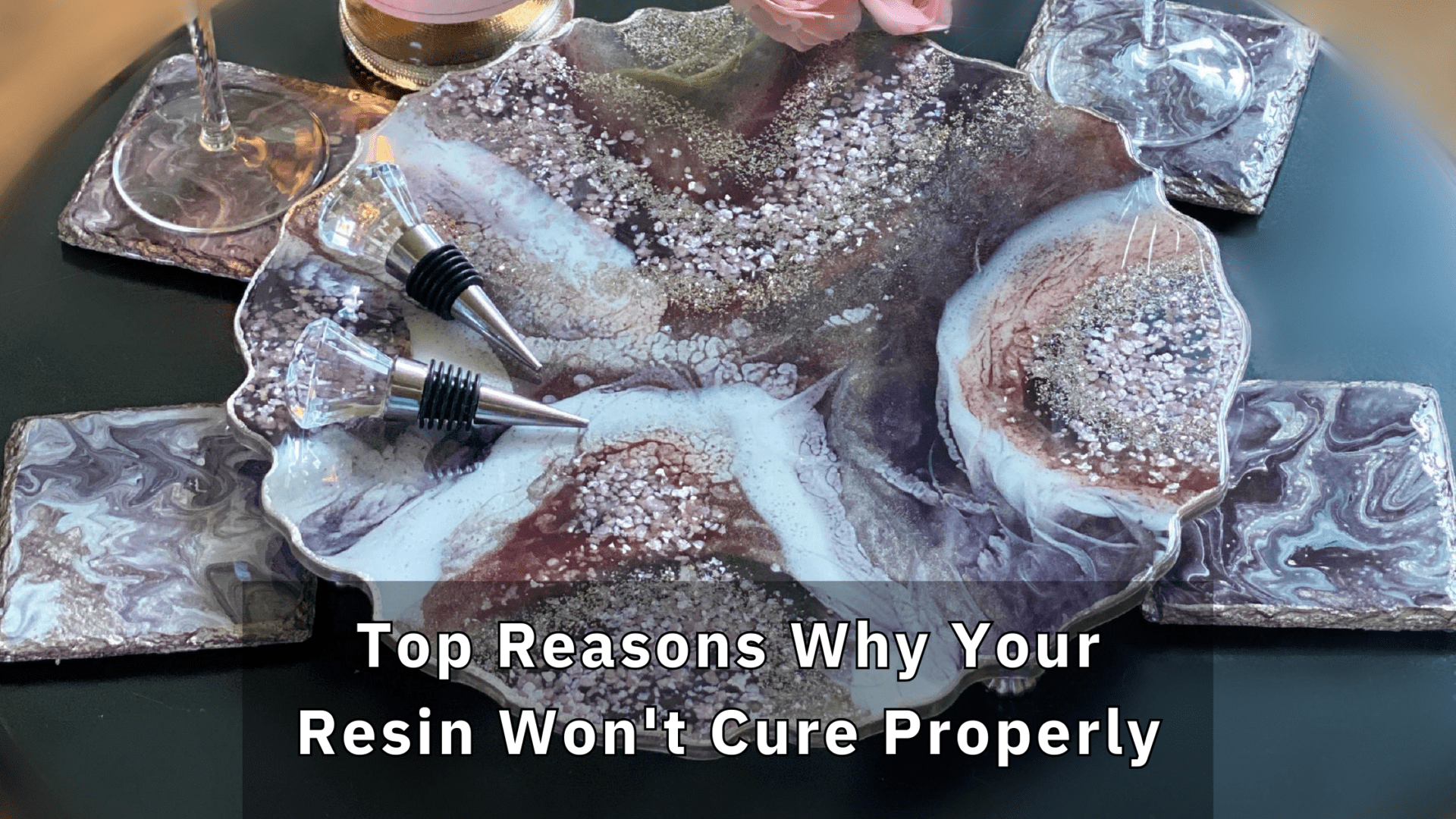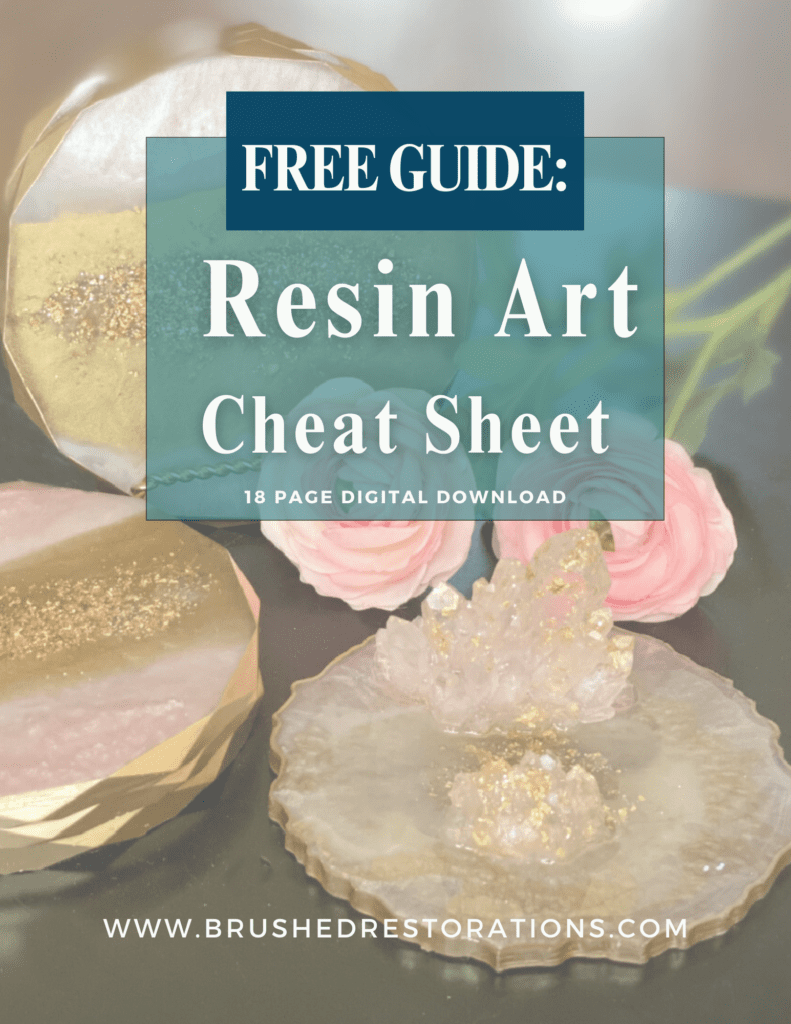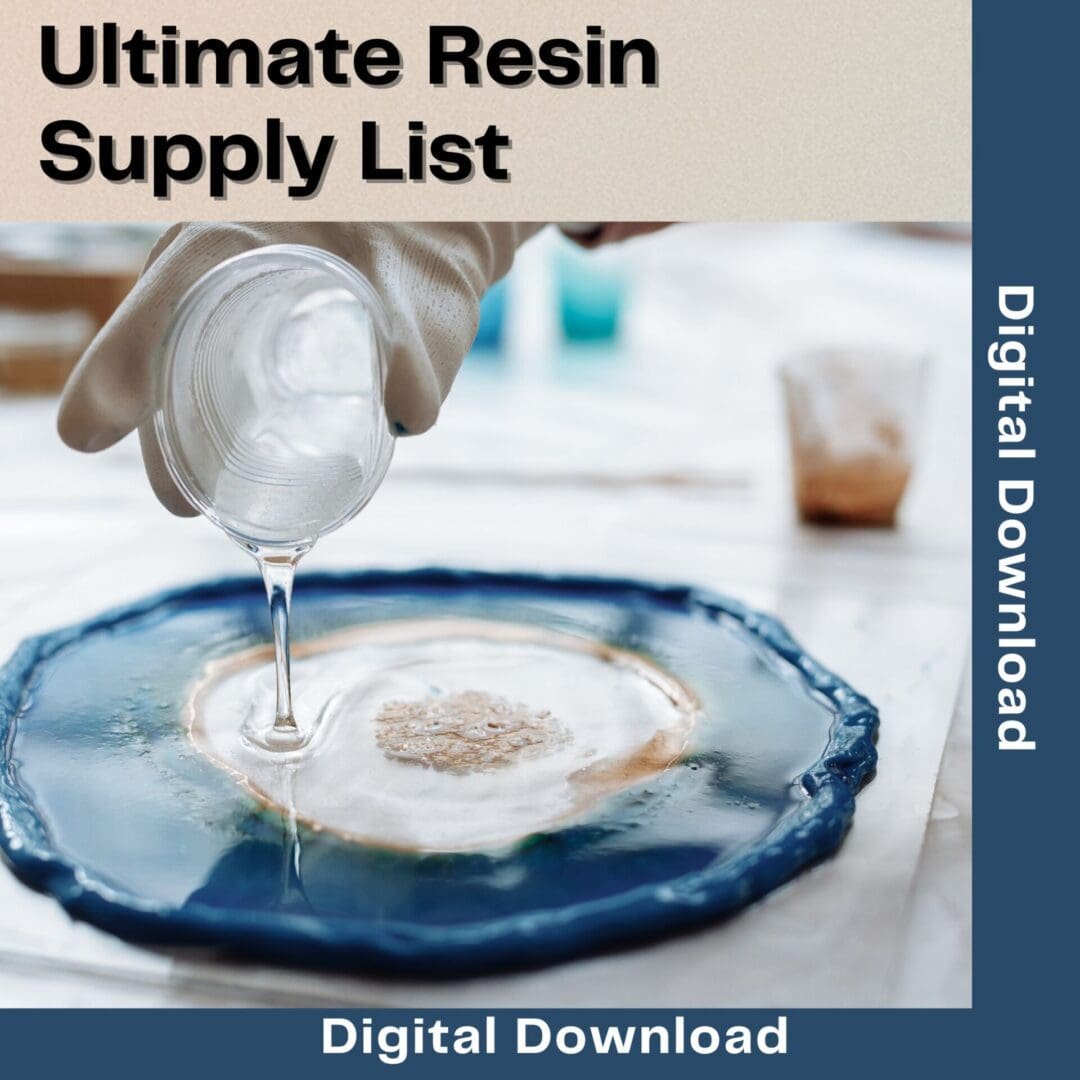Resin Not Curing? Expert Tips to Fix Resin Curing Issues Fast

Diving into resin art is like embarking on a thrilling voyage of creativity. Yet, encountering resin not curing can quickly turn excitement into frustration. As a seasoned mixed media artist with a knack for conquering resin challenges, I’ve charted the course to navigate these treacherous waters. This guide reveals the top reasons your resin art…
Embarking on a resin art project is an exciting journey of creativity and expression. However, the challenge of resin that won’t cure properly can turn this adventure into a frustrating puzzle. Not only does this issue hinder the aesthetic appeal of your artwork, but it also leads to wasted materials and money. As a seasoned mixed media artist specializing in resin, I’ve encountered these hurdles and developed strategies to overcome them. In this post, we’ll delve into the top reasons behind improper resin curing and how my Resin Basics Course and go-to supply list can save you from these costly mistakes.

Before we dive into the solutions, I’ve got a special gift for you! Grab my Free Resin Guide, packed with essential tips and tricks for perfect resin projects every time. Click here to download it now and start enhancing your resin art skills today!
1. Incorrect Resin-to-Hardener Ratio: The Precision Game
Achieving the right mix between resin and hardener is crucial. An incorrect ratio is a primary culprit for resin not curing, leading to a tacky finish that never fully hardens.
Solution & Insight: Precision is key. In my Resin Basics Course, I emphasize the importance of exact measurements and provide tips to get it right every time. Avoid guesswork and invest in quality measuring tools. Be sure to always check the informational sheet or as most companies call it , DATA SHEET, to see what the proper ratio is.
2. Temperature Troubles: Finding the Sweet Spot
Temperature plays a pivotal role in the curing process. To ensure your resin cures properly, maintaining the right temperature is crucial. The ideal temperature range for curing most epoxy resins is between 70-75°F (21-24°C). This temperature range helps the resin to flow easily and ensures proper curing.
Solution & Insight: Ensure your working space is within this temperature range. Keep your resin and hardener at room temperature before mixing them. I cover temperature control techniques in detail in my course, offering practical solutions to create the ideal curing environment. I give the exact tools I use to ensure that my workspace remains at the right temperature.
3. The Mixing Conundrum: Technique Matters
Improper mixing can leave parts of your mixture uncured. It’s not just about stirring; it’s about understanding the chemistry at play.
Solution & Insight: In the Resin Basics Course, you’ll learn my tested mixing methods to ensure a consistent, bubble-free mixture that cures perfectly every time. I also go over some common mistakes and how to fix them if they do happen.
4. Moisture: The Invisible Enemy
Resin’s arch-nemesis, moisture, can sneak in and sabotage your cure. From the air to your materials, it’s a factor that’s often overlooked.
Solution & Insight: To combat moisture issues in resin projects, ensure your working area is dry and consider using a dehumidifier to maintain low humidity levels, especially during mixing and curing phases. This simple step can significantly reduce the risk of uncured or cloudy resin.
5. Product Compatibility and Shelf Life: Avoiding Hidden Pitfalls
Using expired products or incompatible materials can lead to disappointing results. Understanding the lifespan and compatibility of your supplies is essential.
Solution & Insight: It is always important to read the data sheet to see what your products shelf life is.
6. Application Thickness: Knowing Your Limits
Different projects require different resin types. The thickness of your pour can significantly cause resin curing issues. Know Your Resin: Use a resin type specifically formulated for your project’s thickness. Manufacturers often specify the maximum pour depth.
Solution & Insight: There are several different types of resin out there. Be sure to understand what kind of resin you are working with. I go over the different types of resin in my FREE GUIDE.
For Thin Pours:
- Ideal for Coatings: Thin pours, typically less than 1/8 inch (about 3 mm) deep, are perfect for coatings or sealing surfaces.
- Curing Time: They may cure faster due to the larger surface area exposed to air but require careful attention to avoid bubbles and ensure a uniform layer.
For Thick Pours:
- Deep Cast Projects: Thick pours, over 1/8 inch, are suited for casting objects, deep layers, or creating voluminous pieces like river tables.
- Curing Considerations: These require a resin formula designed for deep casts to prevent excessive heat buildup, which can cause cracking or distortion. The curing time is generally longer, allowing for a gradual hardening process that ensures clarity and stability.
7. Additives: The Delicate Balance
While adding colorants and fillers can bring your piece to life, too much can compromise the curing process.
Solution & Insight: Also check out my blog post, Adding Color To Your Resin Art for more information. Learn the art of balance in my course, where I teach you how to enhance your resin art with additives without sacrificing cure quality.
The Cost of Mistakes With Resin Not Curing: Saving Time, Money, and Materials
Every improperly cured piece is not just a setback in your artistic journey; it’s also a loss of valuable resources. My Resin Basics Course is designed to arm you with the knowledge to avoid common mistakes, ensuring that your time, effort, and materials translate into stunning, flawlessly cured art pieces. My expertise will ensure that you minimize the frustrations of your resin not curing!
Not Ready to Dive into the Course? Start with My Curated Supply List
Understanding the need for quality supplies is the first step toward success. If you’re not ready to commit to the course but want to avoid the trial-and-error of product selection, my curated supply list is your shortcut to quality. Featuring only the best products that I personally use and recommend, this list comes with exclusive discounts, ensuring you get the best value for your money.

Frequently Asked Questions (FAQs) About Resin Not Curing
Q: Why won’t my resin cure properly?
A: There are several reasons why resin might not cure properly, including incorrect resin-to-hardener ratios, inadequate mixing, unsuitable temperature conditions, moisture presence, using expired or incompatible products, incorrect application thickness, and overuse of additives.
Q: How crucial is the resin-to-hardener ratio?
A: It’s absolutely vital. The correct ratio ensures that the chemical reaction needed for the resin to cure properly occurs. An incorrect ratio can lead to a tacky finish or a product that never fully hardens.
Q: Can temperature really affect resin curing?
A: Yes, temperature can significantly impact the curing process. If it’s too cold, the resin may remain liquid; if it’s too hot, it might cure too quickly, leading to an uneven finish or cracks.
Q: What’s the best way to mix resin and hardener?
A: The key is to mix thoroughly and slowly to avoid introducing too many air bubbles, which can affect the final finish. It’s also crucial to follow the specific mixing instructions for your resin brand, as the process can vary.
Q: How can I minimize moisture impact on my resin art?
A: Work in a controlled environment where you can manage humidity levels, such as using a dehumidifier. Also, consider choosing your working times carefully, avoiding high humidity conditions.
Q: How do I choose the right resin for my project?
A: Consider the project’s requirements, such as desired finish (matte, glossy, etc.), curing time, and application thickness. My Resin Basics Course offers detailed guidance on selecting the right resin type for different projects.
Q: Can I use any type of colorant or additive in my resin?
A: While many colorants and additives are compatible with resin, it’s essential to use those specifically designed for resin art to avoid curing issues. Overuse of additives can also affect the curing process, so moderation is key.
Q: Is there a way to fix resin that hasn’t cured properly?
A: Depending on the issue, you may be able to apply a fresh layer of correctly mixed resin over the uncured layer. However, for some problems, such as incorrect ratios or contaminated materials, starting over may be necessary.
Q: Where can I find quality supplies for my resin projects?
A: I’ve curated a supply list with high-quality products that I personally use and recommend. This list is designed to help you avoid the trial and error of product selection, and it comes with exclusive discounts. Check out my supply list HERE.
Q: How can I learn more about mastering resin art?
A: My my courses a comprehensive resource designed to help you overcome common challenges and elevate your resin art. From selecting the right materials to detailed tutorials on curing techniques, they cover everything you need to know. Explore my courses HERE.
Have you ever faced issues with getting your resin to cure properly? Share your experiences in the comments below!
Conclusion
Mastering resin art is an achievable goal with the right knowledge and tools. By familiarizing yourself with the common reasons for your resin not curing and leveraging the resources I’ve created, you can save yourself from the frustration of wasted materials and embrace the joy of creating beautiful, durable resin art. Whether you choose to dive into the comprehensive guidance offered in my COURSES or start with the essentials through my curated supply list, you’re on the path to success in your resin art journey.
Be sure to subscribe
Subscribe To Blog
Stay updated with the latest resin art and business tips, tutorials, and exclusive insights from Brushed Restorations. Just drop your name and email below to get inspired right in your inbox!
Hi There, I’m Rosie
I’m a mixed media artist who turned my passion for resin art into a thriving business, Brushed Restorations by Rosie. I love luxury, bold creativity, and helping other artists transform their hobbies into successful businesses. Between creating custom art pieces and teaching online courses, you’ll find me juggling life with my four kids and chasing new ideas to inspire creators like you!
My mission? To empower artists to grow their skills, build their brands, and make their art dreams a reality.








